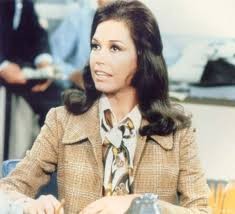I remember how exciting it was when I was finally old enough to stay home with my younger sister without a babysitter. Well, at least without any babysitter other than the Saturday night lineup on CBS! “Have a good time, folks! Don’t worry about a thing!” Jen and I would do up some Jiffy-Pop and start with “The Mary Tyler Moore Show,” head next to Chicago and “The Bob Newhart Show.” Then, Jenny was off to bed, and I got to stick around for “M*A*S*H,” some generic single-season sitcom, and then cap it off with “The Carol Burnett Show.” I’d fidget through the news. And then, after a rousing rendition of the national anthem, I’d be staring at a screen with a three day weather forecast, with instrumental Burt Bacharach music playing in the background. Yes, kids, back then, TV stations actually shut DOWN after the news! I’d stare at the TV wistfully for a bit, wishing to go back, not to the 4077th, or Bob and Emily’s apartment, not even to Mama’s house for a visit with Eunice and Ed. I wished I had some extra time at WJM-TV with Mary, Rhoda, Murray and Lou.
It’s impossible not to smile when we remember Mary Tyler Moore, because it seemed that, even when she WASN’T smiling, the “girl-next-door” grin was lurking just beneath the surface. When Mary passed away this week and I began culling audio for my radio tribute, I happened upon one of the earliest glimpses of her talent, dancing about the screen atop kitchen appliances as Happy Hotpoint the elf. She was struggling with the little ball that was supposed to be the dot over the small “i” in “Hotpoint,” but it kept falling down. She didn’t have a single line, but you still can’t take your eyes off of her. You can find this by searching Happy Hotpoint on YouTube and see it for yourself.
I’ve never seen “Richard Diamond, Private Detective,” which starred David Janssen, I believe. You didn’t see much of Mary there, either, just her gams, and you could hear her sultry voice as Diamond’s receptionist, Sam.
Her ascent to stardom on “The Dick van Dyke Show” is well documented. After auditioning dozens of actresses, an exhausted Sheldon Leonard turned to his business partner, Danny Thomas and said, “What about that girl that tried out to be the daughter on YOUR show, Danny? The one with the three names?” Mary was nervous to read in front of her hero, Carl Reiner, and was terrified when, after she said “Hello,” the producer grabbed the top of her head, literally steered her into Sheldon’s office and said, “Listen to this! She says ‘Hello’ like a regular person!”
The idea behind “The Dick van Dyke Show” was to focus on Rob Petrie’s adventures at work, toiling as a writer for “The Alan Brady Show.” Yes, there would be scenes of the domestic side, but the comedy would undoubtedly come from van Dyke’s interaction with his fellow comedy writers, played by veterans Rose Marie and Morey Amsterdam. But when they shot the ninth episode, Reiner and company realized that Mary had a real gift for comedy. In the storyline, Laura is afraid that Rob has lost interest in her and decides to dye her hair. She gets half-way through when an impromptu phone call from her husband causes her to try and abort the plan. The result is “My Blonde-Haired Brunette.” Mary is a master in the episode, and soon the writers knew that there was comedy gold at home as well as at work.
My other favorite Mary Tyler Moore episodes in the series include “Coast-to-Coast Big Mouth,” recently colorized and broadcast on CBS a few months ago, and her tour-de-force performance in another first season classic called “The Curious Thing About Women.” Also worthy of note is the closing tag to an otherwise forgettable entry called “The Pool Hustler.” The episode closes with the Petries engaging in a friendly game in their downstairs rec room (never seen again in the series), when Laura realizes she’s late to watch her favorite movie on television. Rob admonishes her to please finish the game. All that’s left is a “trick shot.” The plan was to have Mary take the shot, then insert a pool champ MAKING the actual balls sink. The shot really has to be made precisely to work. But the director wisely decided to keep a wide shot just in case. Watch the expression on Mary and Dick’s face as she actually makes the shot. A look of abject astonishment appears on Mary's face. She quickly regains control, salvaging the scene, and smugly says, “I believe that’s the game, Mr. Petrie!” Dick just stands there, scowling at the empty table, slowly shaking his head as the audience explodes with laughter.
When the “Dick van Dyke Show” left the airwaves after five seasons, Mary tried her hand at several motion pictures, but her groundbreaking television work proved more fruitful. With her then-husband Grant Tinker, she tried her own situation comedy, which debuted in 1970 to lackluster reviews, but was truly revolutionary. The odds seemed stacked against the little show that could, even with the melancholy lyrics to the theme song in season one … “How will you make it on your own? This world is awfully big … and girl, this time you’re all alone …”
Mary surrounded herself with show business gold; Valerie Harper, Ed Asner, Gavin McLeod and Ted Knight. She also used Cloris Leachman liberally early on to establish the show. Once the program hit its stride, Betty White was added, and the rest is history.
Much is made of how groundbreaking Mary Richards was, as a single woman, succeeding without a man, on the heels of a failed relationship (a divorce was scuttled, because CBS executives were nervous that viewers would think she’d divorced Dick van Dyke). But to me, the show was REALLY about “Love is All Around.” Who wouldn’t want to work at WJM? Everyone there is loved and appreciated, even the imbecilic anchorman Ted Baxter, who mispronounces “Chicago” in the pilot. I’m fortunate enough to work in such an environment, so they DO exist, but I suspect that they’re rare. It was clear that, as on the “van Dyke Show,” the cast and crew really dug each other, and the chemistry, as well as several Emmys, carried the show for seven seasons.
Much is stated (and rightly so) about the impact that shows like “M*A*S*H,” “Barney Miller,” and “All in the Family” had on character development in television, and the depiction of serious storylines in a comedic setting. “The Mary Tyler Moore Show” also deserves some credit here, as we watch Lou Grant’s long marriage break-up, and our hearts break with his. Another pivotal entry, “The Lars Affair,” regards Phyllis’ never-seen hubby’s fling with Sue Ann Nivens (White), ironically the “Happy Homemaker.” Caught in the middle again, Mary is uncharacteristically harsh to Sue Ann for her behavior, murdering her precious souffle, and while the episode is extremely funny, we also will never look at poor Phyllis the same way again.
“Chuckles Bites the Dust” is the standout episode in the series, a dark comedy in which the station’s kiddie show host is shelled in a parade by an elephant that mistakes him for a peanut. The edginess of this script, in a frankly Pollyanna-esque series, augures the darker comedies to come, like “The Larry Sanders Show” and “Curb Your Enthusiasm.” And Moore is never better than when, after twenty minutes of airtime chiding her co-workers about their callous jokes and remarks, she finds herself unable to stop laughing, mortified, during the funeral.
My personal favorite episodes were the parties. Because Mary Richards could throw a party as well as Charlie Brown could fly a kite. I believe it was the final season in which she was finally going to have a successful gathering, because her congresswoman friend was bringing Johnny Carson. Naturally, moments before Carson’s arrival, the building falls into a blackout. The door opens, and we hear Johnny’s voice saying, “Gotta run, Mary. Great party!”
In addition to her own series, it was Mary and Grant that handpicked the series that would follow hers on Saturday nights, utilizing the talents of accountant-turned-standup comedian Bob Newhart, whose variety show lasted a single season, despite winning an Emmy. It was also MTM that changed the face of television drama forever with “Hill Street Blues” and “St. Elsewhere,” as well as classic series such as “Remington Steele,” “The White Shadow” and “Mary Tyler Moore” spinoffs “Rhoda,” “Phyllis,” and “Lou Grant.”
“The Mary Tyler Moore Show” was among the first to give series closure when Mary decided, as Carl Reiner had almost a decade before, to quit while they were still fresh. Inexplicably, everyone at WJM is fired EXCEPT Ted Baxter, and the television audience wept real tears along with the cast as the group shared a hug and a box of Kleenex in the final episode that has Mary state, “What is a family but people who make you feel … less alone … and loved?”
Mary finally found success on the big screen after she turned out the lights on the WJM newsroom, scoring an Oscar nomination for “Ordinary People” in 1980, in an extraordinary performance. As a recovering alcoholic and diabetic, she was also a forceful advocate for those issues, and even joined White in advocating for animals. She reunited with Harper for a disappointing “Mary & Rhoda” TV-movie, and a slightly more satisfying new “Dick van Dyke Show” episode, which just wasn’t the same without the deceased Amsterdam, Richard Deacon and Jerry Paris. She also teamed with Dick on “The Gin Game” for PBS’ “Great Performances.”
The world that she turned on with her smile is a little dimmer today, but “The Dick van Dyke Show” is streaming on Netflix. A few seasons of “The Mary Tyler Moore Show” can be found on Hulu, and complete SEASONS are a STEAL on ITunes at just $9.99 each. Hollywood has so few show business stories that have “second acts.” That one woman breathed life into both Laura Petrie AND Mary Richards is a gift that can truly be celebrated forever. Second acts? Indeed. She made it after all.










